Thermal and Hydraulic Performance of CuO/Water Nanofluids: A Review
Abstract
1. Introduction
2. Thermal Properties
2.1. Heat Transfer
2.2. Thermal Conductivity
2.3. Nusselt Number
3. Hydraulic Performance
3.1. Viscosity and Density
3.2. Pressure Drop
3.3. Sedimentation and Agglomeration
4. Pumping Power
5. Conclusions
- (1)
- The heat transfer of nanoparticles depends on their material, and is significantly higher with the existence of fins with CuO/water nanofluids and by increasing many factors, such as flow rate, concentration, Peclet number, and chaotic movement of nanoparticles.
- (2)
- Flow rate, volume fraction, and size of particles strongly influence the thermal conductivity of CuO/water nanofluids.
- (3)
- The increase in Ra increases the Nusselt number, flow rate, concentration, and model geometry.
- (4)
- Viscosity depends on the volume fraction and reduction in particle size. However, increasing the temperature of nanofluids decreases their viscosity.
- (5)
- The existence of fins in the flow path of nanofluids significantly increases pressure drop.
- (6)
- The use of surfactants does not affect the pumping power, increases the temperature of nanofluids, decreases the sedimentation and agglomeration of nanoparticles, and negatively impacts the thermal conductivity of nanofluids.
Author Contributions
Funding
Acknowledgments
Conflicts of Interest
References
- Das, S.K.; Choi, S.U.; Yu, W.; Pradeep, T. Nanofluids: Science and Technology; John Wiley & Sons: Hoboken, NJ, USA, 2008. [Google Scholar]
- Vajjha, R.S.; Das, D.K.; Namburu, P.K. Numerical study of fluid dynamic and heat transfer performance of Al2O3 and CuO nanofluids in the flat tubes of a radiator. Int. J. Heat Fluid Flow 2010, 31, 613–621. [Google Scholar] [CrossRef]
- Eapen, J.; Rusconi, R.; Piazza, R.; Yip, S. The classical nature of thermal conduction in nanofluids. J. Heat. Transf. 2010, 132, 102402. [Google Scholar] [CrossRef]
- Chein, R.; Huang, G. Analysis of microchannel heat sink performance using nanofluids. Appl. Eng. 2005, 25, 3104–3114. [Google Scholar] [CrossRef]
- Teng, T.-P.; Hung, Y.-H.; Teng, T.-C.; Mo, H.-E.; Hsu, H.-G. The effect of alumina/water nanofluid particle size on thermal conductivity. Appl. Eng. 2010, 30, 2213–2218. [Google Scholar] [CrossRef]
- Koo, J.; Kleinstreuer, C. A new thermal conductivity model for nanofluids. J. Nanopart. Res. 2004, 6, 577–588. [Google Scholar] [CrossRef]
- Jang, S.P.; Choi, S.U.S. Cooling performance of a microchannel heat sink with nanofluids. Appl. Eng. 2006, 26, 2457–2463. [Google Scholar] [CrossRef]
- Meibodi, M.E.; Vafaie-Sefti, M.; Rashidi, A.M.; Amrollahi, A.; Tabasi, M.; Kalal, H.S. Simple model for thermal conductivity of nanofluids using resistance model approach. Int. Commun. Heat Mass Transf. 2010, 37, 555–559. [Google Scholar] [CrossRef]
- Attalla, M. Experimental investigation of heat transfer and pressure drop of SiO2/water nanofluid through conduits with altered cross-sectional shapes. Heat Mass Transf. 2019, 55, 3427–3442. [Google Scholar] [CrossRef]
- Li, J.; Kleinstreuer, C. Thermal performance of nanofluid flow in microchannels. Int. J. Heat Fluid Flow 2008, 29, 1221–1232. [Google Scholar] [CrossRef]
- Koo, J.; Kleinstreuer, C. Laminar nanofluid flow in microheat-sinks. Int. J. Heat Mass Transf. 2005, 48, 2652–2661. [Google Scholar] [CrossRef]
- Saffarian, M.R.; Moravej, M.; Doranehgard, M.H. Heat transfer enhancement in a flat plate solar collector with different flow path shapes using nanofluid. Renew. Energy 2020, 146, 2316–2329. [Google Scholar] [CrossRef]
- Ali, M.; Shoukat, A.A.; Tariq, H.A.; Anwar, M.; Ali, H. Header design optimization of mini-channel heat sinks using CuO—H2O and Al2O3—H2O nanofluids for thermal management. Arab. J. Sci. Eng. 2019, 44, 10327–10338. [Google Scholar] [CrossRef]
- Zhao, W.; Mozumder, A.K.; Das, P.K. Mixed convection of CuO-water nanofluid in a square enclosure with an intruded rectangular fin. AIP Conf. Proc. 2018, 1980, 50004. [Google Scholar]
- Akdag, U.; Akcay, S.; Demiral, D. Heat transfer in a triangular wavy channel with cuo-water nanofluids under pulsating flow. Science 2019, 23, 191–205. [Google Scholar] [CrossRef]
- Vasefi, S.I.; Bazdidi-Tehrani, F.; Reyhani, L. Assessment of mean and fluctuating velocity and temperature of CuO/water nanofluid in a horizontal channel: Large eddy simulation. Numer. Heat Transf. Part A Appl. 2018, 74, 1520–1538. [Google Scholar] [CrossRef]
- Zarringhalam, M.; Karimipour, A.; Toghraie, D. Experimental study of the effect of solid volume fraction and Reynolds number on heat transfer coefficient and pressure drop of CuO-water nanofluid. Exp. Fluid Sci. 2016, 76, 342–351. [Google Scholar] [CrossRef]
- Li, C.H.; Peterson, G.P. The effect of particle size on the effective thermal conductivity of Al2O3-water nanofluids. J. Appl. Phys. 2007, 101, 44312. [Google Scholar] [CrossRef]
- Lee, S.; Choi, S.-S.; Li, S.; Eastman, J.A. Measuring thermal conductivity of fluids containing oxide nanoparticles. J. Heat Transfer. 1999, 121, 280–289. [Google Scholar] [CrossRef]
- Shima, P.D.; Philip, J.; Raj, B. Role of microconvection induced by Brownian motion of nanoparticles in the enhanced thermal conductivity of stable nanofluids. Appl. Phys. Lett. 2009, 94, 223101. [Google Scholar] [CrossRef]
- Xuan, Y.; Li, Q. Heat transfer enhancement of nanofluids. Int. J. Heat Fluid Flow 2000, 21, 58–64. [Google Scholar] [CrossRef]
- Murshed, S.M.S.; Leong, K.C.; Yang, C. Enhanced thermal conductivity of TiO2—Water based nanofluids. Int. J. Sci. 2005, 44, 367–373. [Google Scholar] [CrossRef]
- Torii, S.; Satou, Y.; Koito, Y. Experimental study on convective thermal-fluid flow transport phenomena in circular tube using nanofluids. Int. J. Green Energy 2010, 7, 289–299. [Google Scholar] [CrossRef]
- Fotukian, S.M.; Esfahany, M.N. Experimental study of turbulent convective heat transfer and pressure drop of dilute CuO/water nanofluid inside a circular tube. Int. Commun. Heat Mass Transf. 2010, 37, 214–219. [Google Scholar] [CrossRef]
- Wu, X.; Wu, H.; Cheng, P. Pressure drop and heat transfer of Al2O3-H2O nanofluids through silicon microchannels. J. Micromech. Microeng. 2009, 19, 105020. [Google Scholar] [CrossRef]
- Ho, C.-J.; Wei, L.C.; Li, Z.W. An experimental investigation of forced convective cooling performance of a microchannel heat sink with Al2O3/water nanofluid. Appl. Eng. 2010, 30, 96–103. [Google Scholar] [CrossRef]
- Jung, J.-Y.; Oh, H.-S.; Kwak, H.-Y. Forced convective heat transfer of nanofluids in microchannels. Int. J. Heat Mass Transf. 2009, 52, 466–472. [Google Scholar] [CrossRef]
- Nassan, T.H.; Heris, S.Z.; Noie, S.H. A comparison of experimental heat transfer characteristics for Al2O3/water and CuO/water nanofluids in square cross-section duct. Int. Commun. Heat Mass Transf. 2010, 37, 924–928. [Google Scholar] [CrossRef]
- Salman, S.D.; Alsaheb, R.A.A. Numerical Investigations on heat flow of nanofluids in ribs tube configurations. Al Khwarizmi Eng. J. 2017, 13, 10–17. [Google Scholar] [CrossRef][Green Version]
- Kole, M.; Dey, T.K. Thermal conductivity and viscosity of Al2O3 nanofluid based on car engine coolant. J. Phys. D Appl. Phys. 2010, 43, 315501. [Google Scholar] [CrossRef]
- Palaniappan, B.; Ramasamy, V. Thermodynamic analysis of fly ash nanofluid for automobile (heavy vehicle) radiators. J. Anal. Calorim. 2019, 136, 223–233. [Google Scholar] [CrossRef]
- Bharadwaj, B.R.; Mogeraya, K.S.; Manjunath, D.M.; Ponangi, B.R.; Prasad, K.S.R.; Krishna, V. CFD analysis of heat transfer performance of graphene based hybrid nanofluid in radiators. In Proceedings of the IOP Conference Series: Materials Science and Engineering, Dubai, UAE, 28–29 November 2017. [Google Scholar]
- Oliveira, G.A.; Bandarra Filho, E.P. Nanofluid as a coolant in automotive radiators. In Proceedings of the 10th International Conference on Heat Transfer, Fluid Mechanics and Thermodynamics, Orlando, FL, USA, 14–16 July 2014. [Google Scholar]
- Fotukian, S.M.; Esfahany, M.N. Experimental investigation of turbulent convective heat transfer of dilute γ-Al2O3/water nanofluid inside a circular tube. Int. J. Heat Fluid Flow 2010, 31, 606–612. [Google Scholar] [CrossRef]
- Akbari, O.A.; Toghraie, D.; Karimipour, A. Numerical simulation of heat transfer and turbulent flow of water nanofluids copper oxide in rectangular microchannel with semi-attached rib. Adv. Mech. Eng. 2016, 8, 1687814016641016. [Google Scholar] [CrossRef]
- Asirvatham, L.G.; Vishal, N.; Gangatharan, S.K.; Lal, D.M. Experimental study on forced convective heat transfer with low volume fraction of CuO/water nanofluid. Energies 2009, 2, 97–119. [Google Scholar] [CrossRef]
- Jahanbin, A.H.; Javaherdeh, K. Numerical investigation of CuO nanoparticles effect on forced convective heat transfer inside a mini-channel: Comparison of different approaches. Life Sci. J. 2013, 10, 183–189. [Google Scholar]
- Liang, G.; Mudawar, I. Review of single-phase and two-phase nanofluid heat transfer in macro-channels and micro-channels. Int. J. Heat Mass Transf. 2019, 136, 324–354. [Google Scholar] [CrossRef]
- Om, N.I.; Zulkifli, R.; Gunnasegaran, P. Influence of the oblique fin arrangement on the fluid flow and thermal performance of liquid cold plate. Case Stud. Eng. 2018, 12, 717–727. [Google Scholar] [CrossRef]
- Om, N.I.; Zulkifli, R.; Gunnasegaran, P. The influence of different types of nanofluid on thermal and fluid flow performance of liquid cold plate. Int. J. Eng. Technol. 2018, 7, 148–152. [Google Scholar]
- Marcelino, E.W.; Riehl, R.R.; de Silva, O.D. A review on thermal performance of CuO-water nanofluids applied to heat pipes and their characteristics. In Proceedings of the 2016 15th IEEE Intersociety Conference on Thermal and Thermomechanical Phenomena in Electronic Systems (ITherm), Las Vegas, NV, USA, 31 May–3 June 2016; pp. 12–22. [Google Scholar]
- Oldenburg, S.J.; Siekkinen, A.R.; Darlington, T.K.; Baldwin, R.K. Optimized nanofluid coolants for spacecraft thermal control systems. SAE Trans. 2007, 116, 152–157. [Google Scholar]
- Balla, H.H.; Abdullah, S.; Faizal, W.M.W.M.; Zulkifli, R.; Sopian, K. Enhancement of heat transfer coefficient multi-metallic nanofluid with ANFIS modeling for thermophysical properties. Science 2015, 19, 1613–1620. [Google Scholar] [CrossRef]
- Saidur, R.; Leong, K.Y.; Mohammed, H.A. A review on applications and challenges of nanofluids. Renew. Sustain. Energy Rev. 2011, 15, 1646–1668. [Google Scholar] [CrossRef]
- Yu, W.; Xie, H. A review on nanofluids: Preparation, stability mechanisms, and applications. J. Nanomater. 2012, 2012. [Google Scholar] [CrossRef]
- Bai, M.; Xu, Z.; Lv, J. Application of Nanofluids in Engine Cooling System; SAE Technical Paper: Warrendale, PA, USA, 2008. [Google Scholar]
- Mondal, B.; Lopez, C.F.; Mukherjee, P.P. Exploring the efficacy of nanofluids for lithium-ion battery thermal management. Int. J. Heat Mass Transf. 2017, 112, 779–794. [Google Scholar] [CrossRef]
- Salman, S.D.; Kadhum, A.A.H.; Takriff, M.S.; Mohamad, A.B. Heat transfer enhancement of laminar flow in a circular tube using swirl/vortex generator (peningkatan pemindahan haba aliran lamina di dalam tabung membulat menggunakan penjana swirl/vorteks). J. Kejuruter. J. Eng. 2014, 26, 63–68. [Google Scholar]
- Shoghl, S.N.; Jamali, J.; Moraveji, M.K. Electrical conductivity, viscosity, and density of different nanofluids: An experimental study. Exp. Fluid Sci. 2016, 74, 339–346. [Google Scholar] [CrossRef]
- Mahbubul, I.M.; Saidur, R.; Amalina, M.A. Thermal conductivity, viscosity and density of R141b refrigerant based nanofluid. Procedia Eng. 2013, 56, 310–315. [Google Scholar] [CrossRef]
- Vajjha, R.S.; Das, D.K. Measurements of specific heat and density of Al2O3 nanofluid. AIP Conf. Proc. 2008, 1063, 361–370. [Google Scholar]
- Mahian, O.; Kianifar, A.; Wongwises, S. Dispersion of ZnO nanoparticles in a mixture of ethylene glycol–water, exploration of temperature-dependent density, and sensitivity analysis. J. Clust. Sci. 2013, 24, 1103–1114. [Google Scholar] [CrossRef]
- Kulkarni, D.P.; Das, D.K.; Vajjha, R.S. Application of nanofluids in heating buildings and reducing pollution. Appl. Energy 2009, 86, 2566–2573. [Google Scholar] [CrossRef]
- Nguyen, C.T.; Desgranges, F.; Galanis, N.; Roy, G.; Maré, T.; Boucher, S.; Mintsa, H.A. Viscosity data for Al2O3—Water nanofluid—Hysteresis: Is heat transfer enhancement using nanofluids reliable? Int. J. Sci. 2008, 47, 103–111. [Google Scholar] [CrossRef]
- Rudyak, V.Y.; Minakov, A. V Thermophysical properties of nanofluids. Eur. Phys. J. E 2018, 41, 15. [Google Scholar] [CrossRef]
- Mintsa, H.A.; Roy, G.; Nguyen, C.T.; Doucet, D. New temperature dependent thermal conductivity data for water-based nanofluids. Int. J. Sci. 2009, 48, 363–371. [Google Scholar] [CrossRef]
- Timofeeva, E.V.; Smith, D.S.; Yu, W.; France, D.M.; Singh, D.; Routbort, J.L. Particle size and interfacial effects on thermo-physical and heat transfer characteristics of water-based α-SiC nanofluids. Nanotechnology 2010, 21, 215703. [Google Scholar] [CrossRef] [PubMed]
- Pryazhnikov, M.I.; Minakov, A.V.; Rudyak, V.Y.; Guzei, D. V Thermal conductivity measurements of nanofluids. Int. J. Heat Mass Transf. 2017, 104, 1275–1282. [Google Scholar] [CrossRef]
- Rudyak, V.Y.; Belkin, A.A.; Tomilina, E.A. On the thermal conductivity of nanofluids. Tech. Phys. Lett. 2010, 36, 660–662. [Google Scholar] [CrossRef]
- Keblinski, P.; Prasher, R.; Eapen, J. Thermal conductance of nanofluids: Is the controversy over? J. Nanopart. Res. 2008, 10, 1089–1097. [Google Scholar] [CrossRef]
- Faris Abdullah, M.; Zulkifli, R.; Harun, Z.; Abdullah, S.; Ghopa, W.; Aizon, W.; Soheil Najm, A.; Humam Sulaiman, N. Impact of the TiO2 nanosolution concentration on heat transfer enhancement of the twin impingement jet of a heated aluminum Plate. Micromachines 2019, 10, 176. [Google Scholar] [CrossRef]
- Duangthongsuk, W.; Wongwises, S. Heat transfer enhancement and pressure drop characteristics of TiO2–water nanofluid in a double-tube counter flow heat exchanger. Int. J. Heat Mass Transf. 2009, 52, 2059–2067. [Google Scholar] [CrossRef]
- Zaraki, A.; Ghalambaz, M.; Chamkha, A.J.; Ghalambaz, M.; De Rossi, D. Theoretical analysis of natural convection boundary layer heat and mass transfer of nanofluids: Effects of size, shape and type of nanoparticles, type of base fluid and working temperature. Adv. Powder Technol. 2015, 26, 935–946. [Google Scholar] [CrossRef]
- Hu, Y.; He, Y.; Qi, C.; Jiang, B.; Schlaberg, H.I. Experimental and numerical study of 870 natural convection in a square enclosure filled with nanofluid. Int. J. Heat Mass 2014, 78, 380–392. [Google Scholar] [CrossRef]
- Ho, C.-J.; Liu, W.K.; Chang, Y.S.; Lin, C.C. Natural convection heat transfer of alumina-water nanofluid in vertical square enclosures: An experimental study. Int. J. Sci. 2010, 49, 1345–1353. [Google Scholar] [CrossRef]
- Chein, R.; Chuang, J. Experimental microchannel heat sink performance studies using nanofluids. Int. J. Sci. 2007, 46, 57–66. [Google Scholar] [CrossRef]
- Heris, S.Z.; Etemad, S.G.; Esfahany, M.N. Experimental investigation of oxide nanofluids laminar flow convective heat transfer. Int. Commun. Heat Mass Transf. 2006, 33, 529–535. [Google Scholar] [CrossRef]
- Peyghambarzadeh, S.M.; Hashemabadi, S.H.; Chabi, A.R.; Salimi, M. Performance of water based CuO and Al2O3 nanofluids in a Cu—Be alloy heat sink with rectangular microchannels. Energy Convers. Manag. 2014, 86, 28–38. [Google Scholar] [CrossRef]
- Afzal, A.; Samee, A.D.M.; Razak, R.K.A. Experimental thermal investigation of CuO-W nanofluid in circular minichannel. Model Meas. Control B 2017, 86, 335–344. [Google Scholar] [CrossRef]
- Pantzali, M.N.; Kanaris, A.G.; Antoniadis, K.D.; Mouza, A.A.; Paras, S. V Effect of nanofluids on the performance of a miniature plate heat exchanger with modulated surface. Int. J. Heat Fluid Flow 2009, 30, 691–699. [Google Scholar] [CrossRef]
- Sivakumar, A.; Alagumurthi, N.; Senthilvelan, T. Experimental investigation of forced convective heat transfer performance in nanofluids of Al2O3/water and CuO/water in a serpentine shaped micro channel heat sink. Heat Mass Transf. 2016, 52, 1265–1274. [Google Scholar] [CrossRef]
- Tran, L.; Lopez, J.; Lopez, J.; Uriostegui, A.; Barrera, A.; Wiggins, N. Li-ion battery cooling system integrates in nano-fluid environment. Appl. Nanosci. 2017, 7, 25–29. [Google Scholar] [CrossRef]
- Byrne, M.D.; Hart, R.A.; da Silva, A.K. Experimental thermal–hydraulic evaluation of CuO nanofluids in microchannels at various concentrations with and without suspension enhancers. Int. J. Heat Mass Transf. 2012, 55, 2684–2691. [Google Scholar] [CrossRef]
- Mammeri, A.; Bakir, F.; Kouidri, S.; Coutancier, L.; Bonnin, J.-C. Enhancing heat transfer in a cold plate, inserts vs. nanofluids: Application to IT servers. In Proceedings of the ASME 2013 International Technical Conference and Exhibition on Packaging and Integration of Electronic and Photonic Microsystems, Burlingame, CA, USA, 16–18 July 2013. [Google Scholar]
- Benenson, W.; Harris, J.W.; Stöcker, H.; Lutz, H. Handbook of Physics; Springer Science & Business Media: Berlin/Heidelberg, Germany, 2006. [Google Scholar]
- Boles, M.; Cengel, Y. An Engineering Approach; McGraw-Hill Education: New York, NY, USA, 2014. [Google Scholar]
- Buongiorno, J. Convective transport in nanofluids. J. Heat Transfer. 2006, 128, 240–250. [Google Scholar] [CrossRef]
- Palm, S.J.; Roy, G.; Nguyen, C.T. Heat transfer enhancement with the use of nanofluids in radial flow cooling systems considering temperature-dependent properties. Appl. Eng. 2006, 26, 2209–2218. [Google Scholar] [CrossRef]
- Mansour, R.B.; Galanis, N.; Nguyen, C.T. Effect of uncertainties in physical properties on forced convection heat transfer with nanofluids. Appl. Eng. 2007, 27, 240–249. [Google Scholar] [CrossRef]
- Sarviya, R.M.; Fuskele, V. Review on thermal conductivity of nanofluids. Mater. Today Proc. 2017, 4, 4022–4031. [Google Scholar] [CrossRef]
- Sheikholeslami, M. CuO-water nanofluid free convection in a porous cavity considering Darcy law. Eur. Phys. J. Plus 2017, 132, 55. [Google Scholar] [CrossRef]
- Hung, T.-C.; Yan, W.-M. Enhancement of thermal performance in double-layered microchannel heat sink with nanofluids. Int. J. Heat Mass Transf. 2012, 55, 3225–3238. [Google Scholar] [CrossRef]
- Zhou, L.-P.; Wang, B.-X.; Peng, X.-F.; Du, X.-Z.; Yang, Y.-P. On the specific heat capacity of CuO nanofluid. Adv. Mech. Eng. 2010, 2, 172085. [Google Scholar] [CrossRef]
- Hamilton, R.L.; Crosser, O.K. Thermal conductivity of heterogeneous two-component systems. Ind. Eng. Chem. Fundam. 1962, 1, 187–191. [Google Scholar] [CrossRef]
- Sheikholeslami, M.; Seyednezhad, M. Lattice Boltzmann method simulation for CuO-water nanofluid flow in a porous enclosure with hot obstacle. J. Mol. Liq. 2017, 243, 249–256. [Google Scholar] [CrossRef]
- Kefayati, G.H.R.; Hosseinizadeh, S.F.; Gorji, M.; Sajjadi, H. Lattice Boltzmann simulation of natural convection in an open enclosure subjugated to water/copper nanofluid. Int. J. Sci. 2012, 52, 91–101. [Google Scholar] [CrossRef]
- Pastoriza-Gallego, M.J.; Casanova, C.; Legido, J.L.; Piñeiro, M.M. CuO in water nanofluid: Influence of particle size and polydispersity on volumetric behaviour and viscosity. Fluid Phase Equilib. 2011, 300, 188–196. [Google Scholar] [CrossRef]
- Rudyak, V.Y. Viscosity of nanofluids. Why it is not described by the classical theories. Adv. Nanoparticles 2013, 2, 266. [Google Scholar] [CrossRef]
- Oueslati, F.S.; Bennacer, R. Heterogeneous nanofluids: Natural convection heat transfer enhancement. Nanoscale Res. Lett. 2011, 6, 222. [Google Scholar] [CrossRef] [PubMed]
- Venerus, D.C.; Buongiorno, J.; Christianson, R.; Townsend, J.; Bang, I.C.; Chen, G.; Chung, S.J.; Chyu, M.; Chen, H.; Ding, Y.; et al. Viscosity measurements on colloidal dispersions (nanofluids) for heat transfer applications. Appl. Rheol. 2010, 20, 11–17. [Google Scholar]
- Pak, B.C.; Cho, Y.I. Hydrodynamic and heat transfer study of dispersed fluids with submicron metallic oxide particles. Exp. Heat Transf. Int. J. 1998, 11, 151–170. [Google Scholar] [CrossRef]
- Wang, X.; Xu, X.; Choi, S.U.S. Thermal conductivity of nanoparticle-fluid mixture. J. Heat Transf. 1999, 13, 474–480. [Google Scholar] [CrossRef]
- Wang, X.-Q.; Mujumdar, A.S. A review on nanofluids—Part I: Theoretical and numerical investigations. Braz. J. Chem. Eng. 2008, 25, 613–630. [Google Scholar] [CrossRef]
- Anwar, M.; Tariq, H.A.; Shoukat, A.A.; Ali, H.M.; Ali, H. Numerical study for heat transfer enhancement using CuO-H2O nano-fluids through mini-channel heat sinks for microprocessor cooling. Science 2019, 22. [Google Scholar] [CrossRef]
- Sivasubramanian, M.; Theivasanthi, T.; Manimaran, R. Experimental investigation on heat transfer enhancement in a minichannel using CuO-water nanofluid. Int. J. Ambient Energy 2019, 40, 847–853. [Google Scholar] [CrossRef]
- Mansouri, M.; Zamzamian, A.; Shafiefarhood, A.; Tavakoli, O.; Tajik, M. Investigation on effect of nanoparticles sedimentation on thermal conductivity of SiO2 nanofluids. In Proceedings of the 7th International Chemical Engineering Congress & Exhibition (IChEC 2011), Kish, Iran, 21–24 November 2011. [Google Scholar]
- Zav, A.P.; Syzrantsev, V.V.; Zobov, K.V.; Bardakhanov, S.P. Influence of agglomeration on the viscosity of nanofluids. J. Eng. Phys. 2018, 91, 115–123. [Google Scholar]
- Taha-Tijerina, J.J. Thermal transport and challenges on nanofluids performance. In Microfluidics and Nanofluidics; InTech: Charlotte, NC, USA, 2018; Volume 1, pp. 215–256. [Google Scholar]
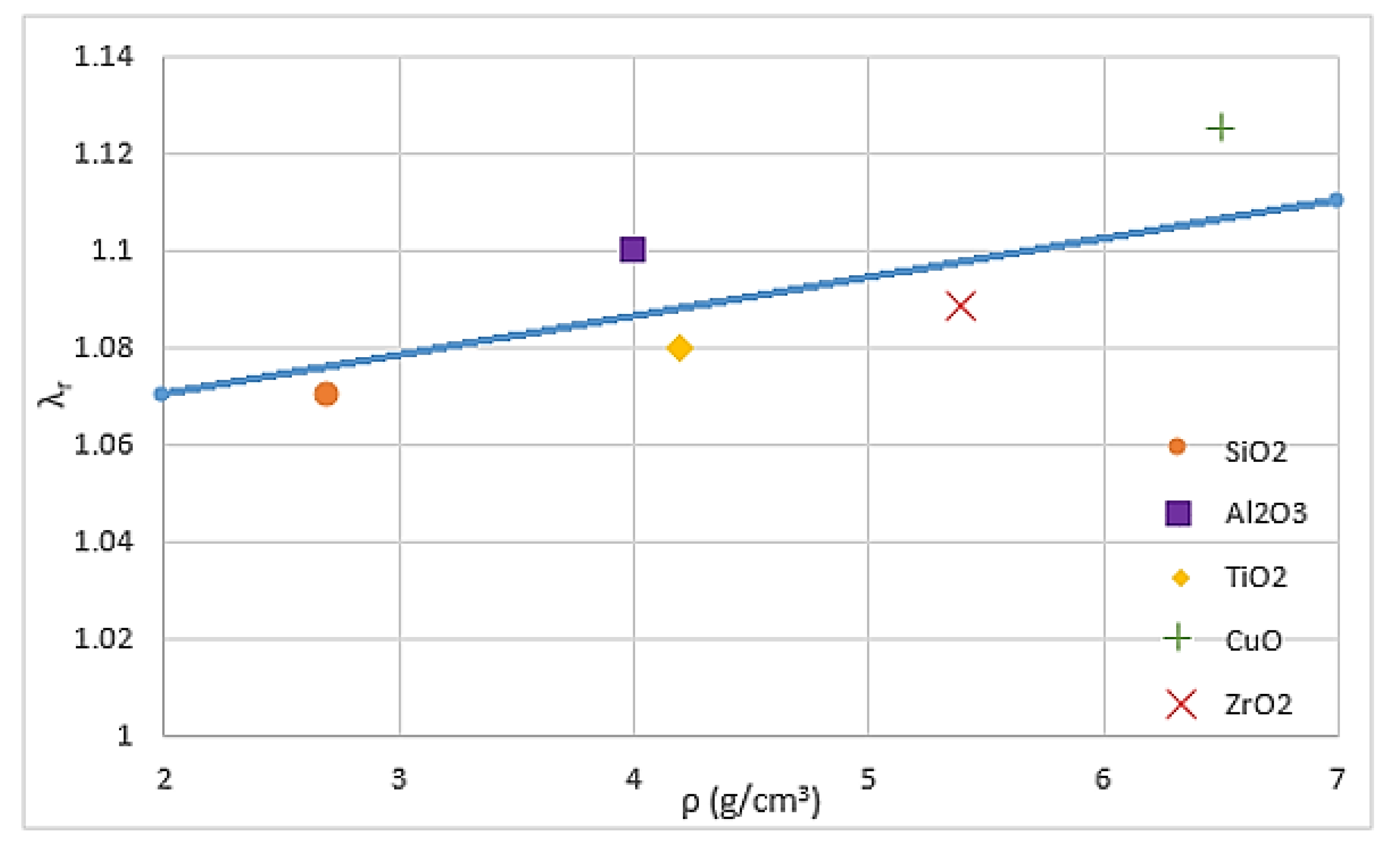
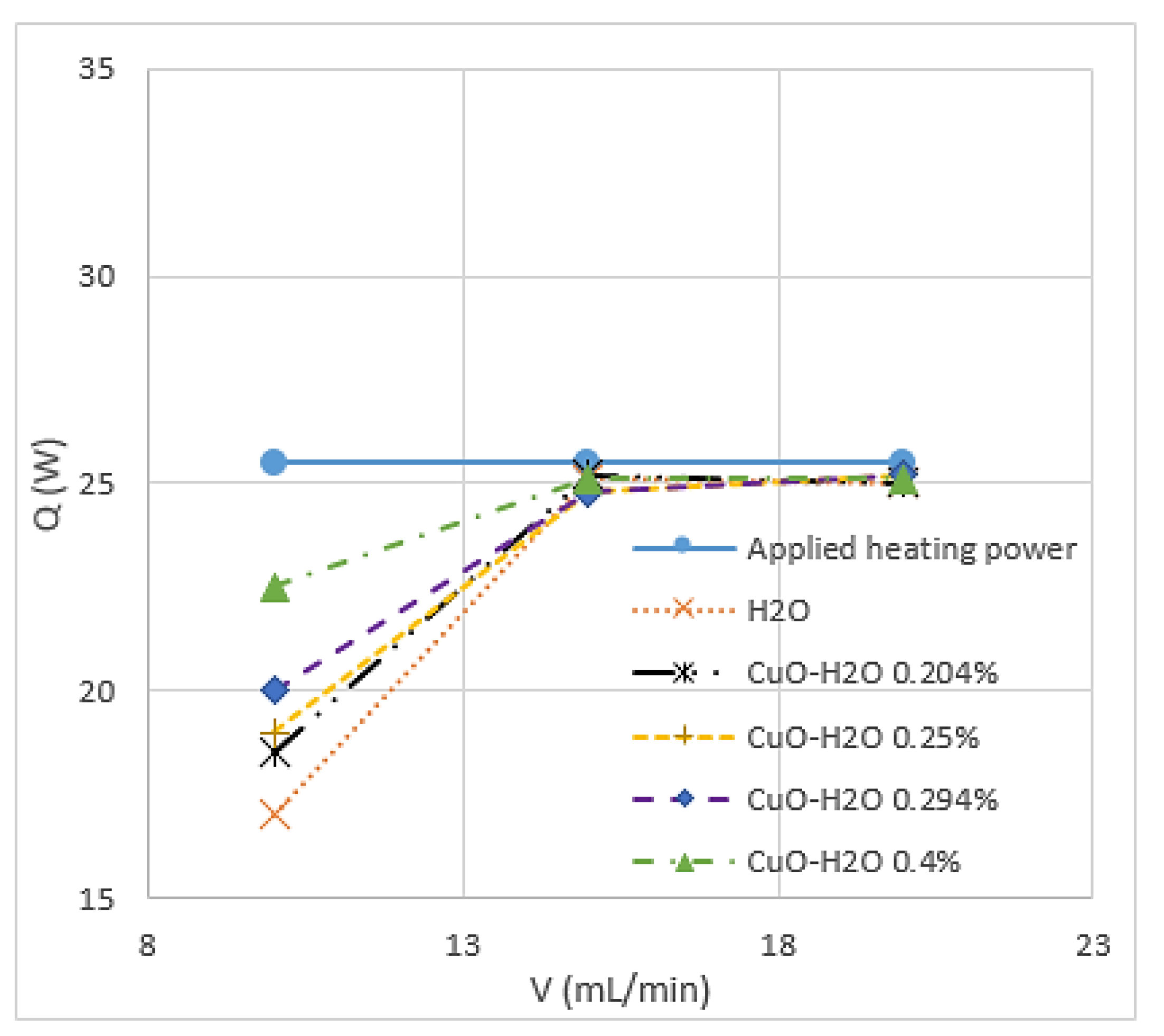

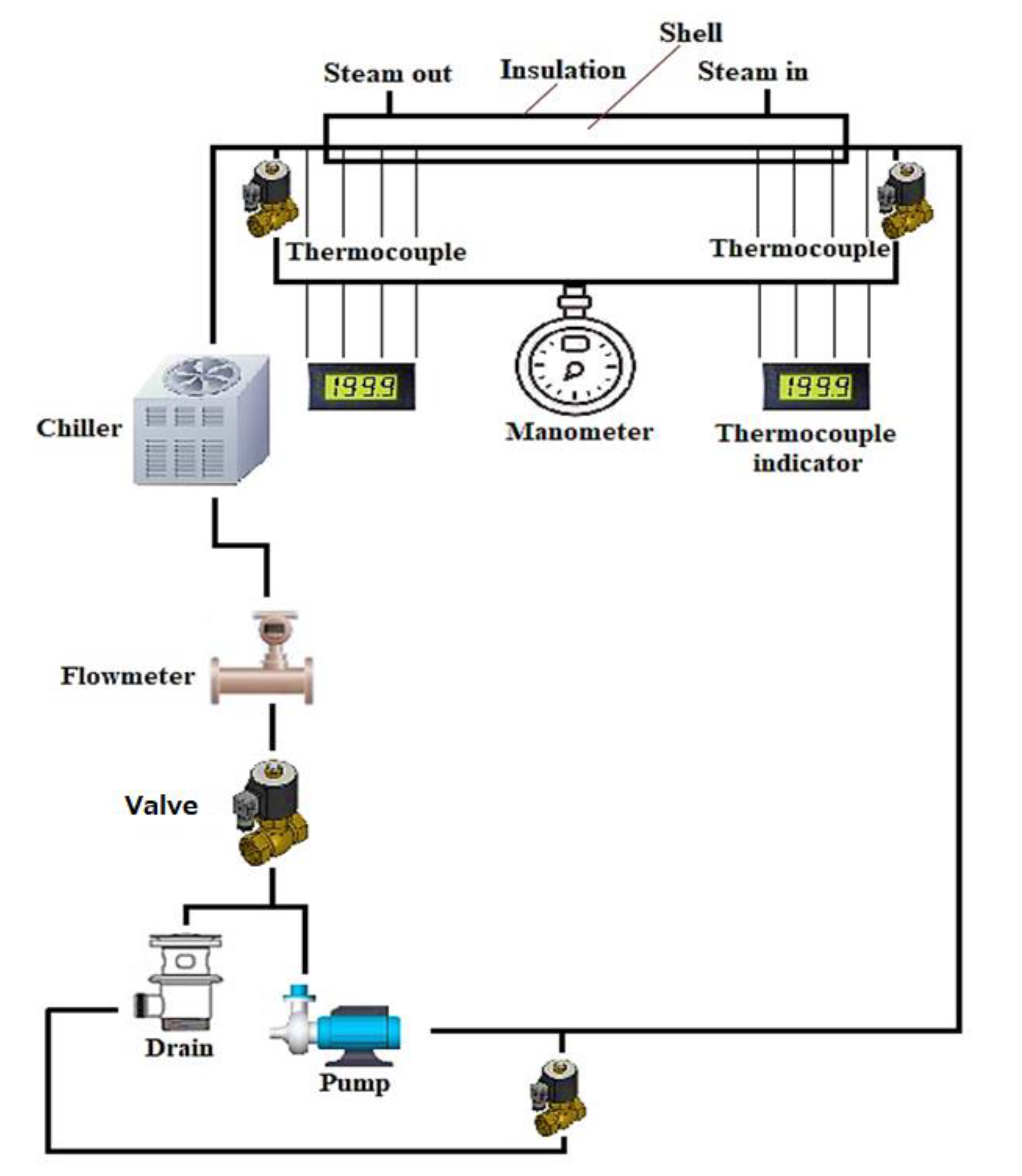

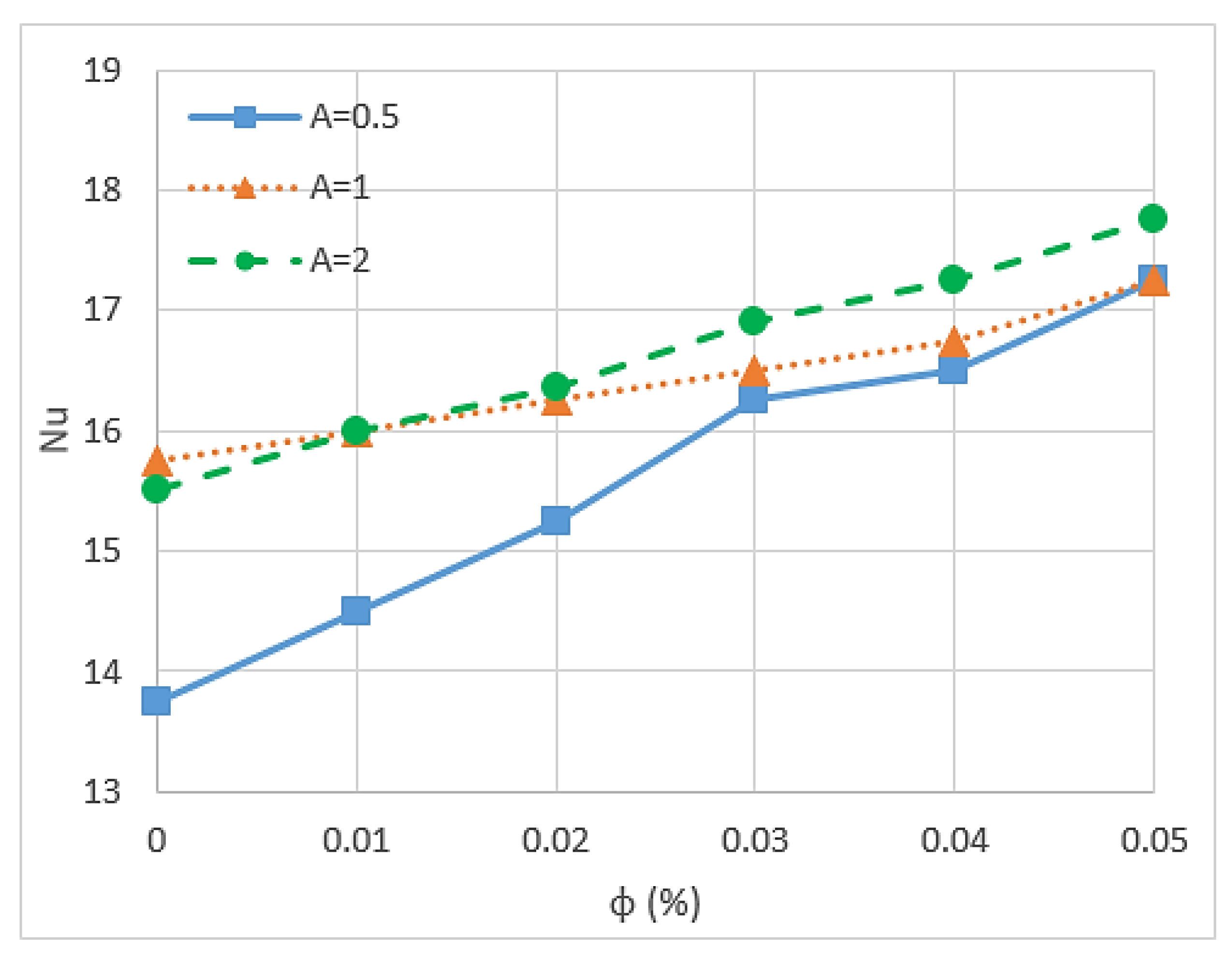

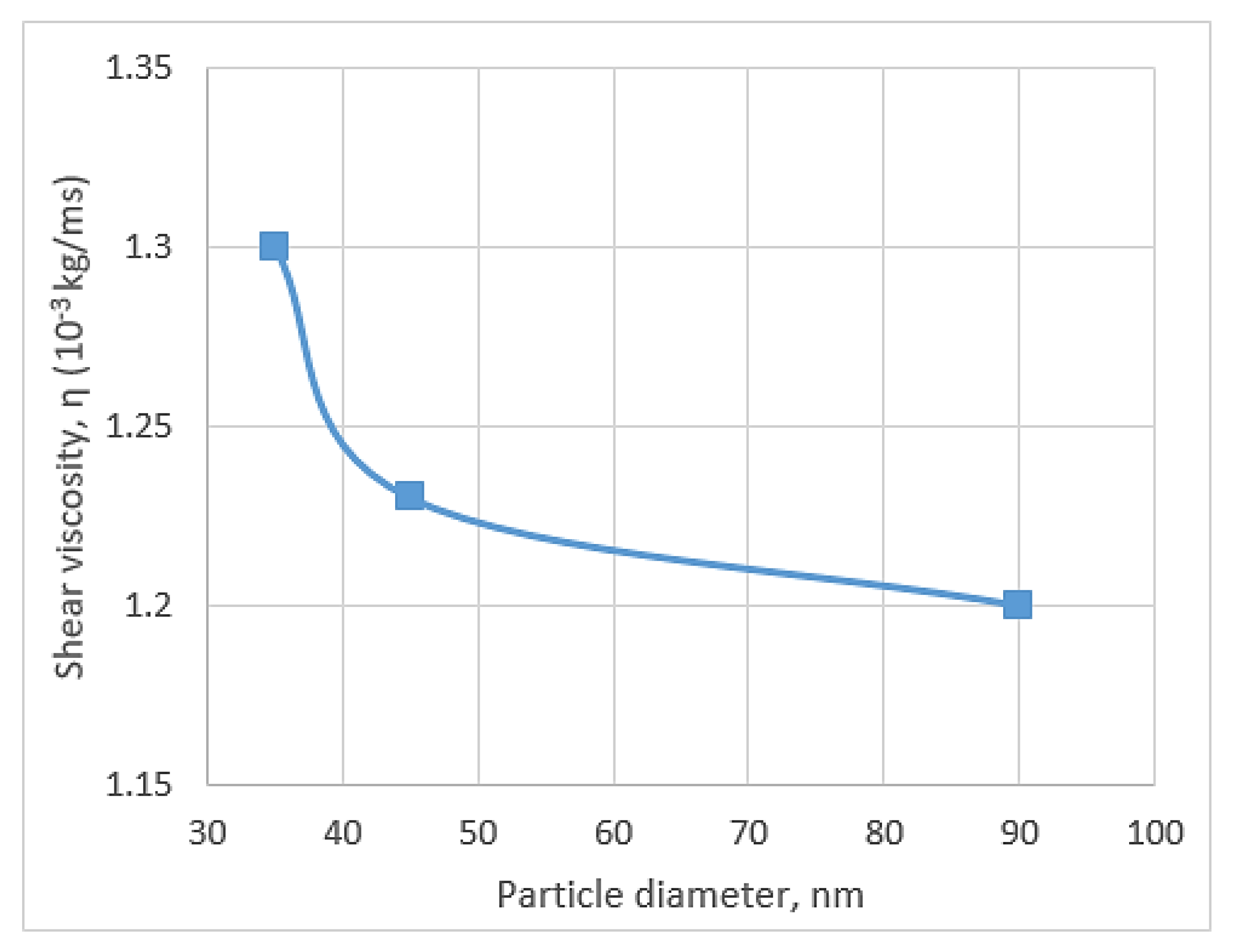
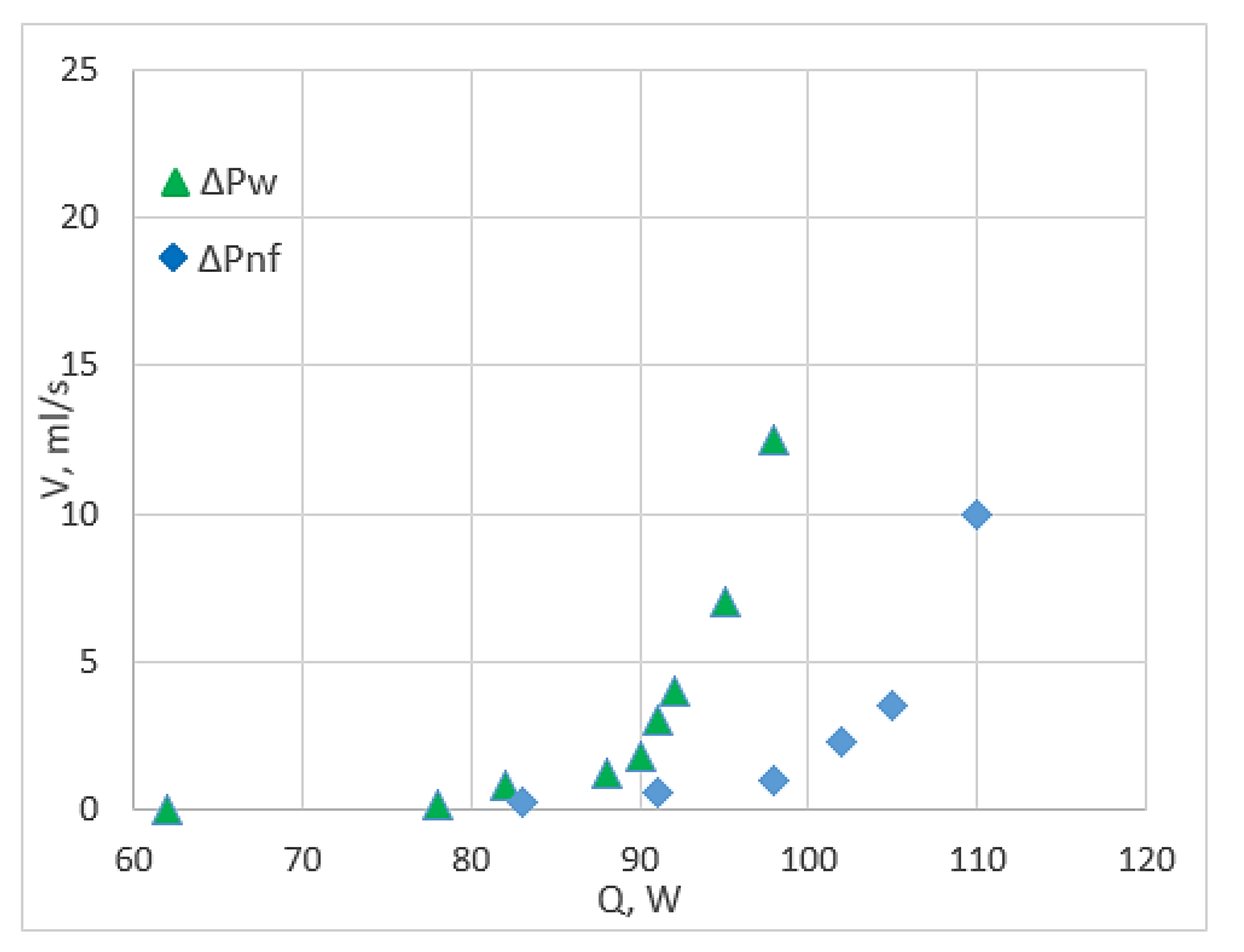
| Number | Test Type | Model | Particle Size (nm) a | Volume Fraction (%) | Other Nanofluids Used in the Study | Reference Number |
|---|---|---|---|---|---|---|
| 1 | Experimental and theoretical | Rectangular cavity | 29 | 40 | Al2O3/water (36 nm, 67%) | 13 |
| 2 | Theoretical | Square lid-driven enclosure | Unknown b | 1, 2, 4 | - | 14 |
| 3 | Theoretical | Triangular wavy channel | 30 | 5 | - | 15 |
| 4 | Theoretical | Rectangular microchannel | 40 | 1.5 | - | 16 |
| 5 | Experimental | Double-tube heat exchanger | 40 | 0.0625, 0.125, 0.25, 0.5, 1, 1.5, 2 | - | 17 |
| 6 | Theoretical | Triangular microchannel | 100 | 0, 2, 4 | - | 36 |
| 7 | Experimental and theoretical | Copper tube | 40 | 0.3 | - | 37 |
| 8 | Theoretical | Circular cross-section minichannel | Unknown | 10, 30 | - | 38 |
| 9 | Experimental and theoretical | Rectangular cavity | 80 × 20 rectangular | 20–40 | - | 62 |
| 10 | Theoretical | Annular copper tube | 50, 60 | 0.2, 1, 2, 2.5, 3 | Al2O3/water (20 nm, similar) | 63 |
| 11 | Experimental and theoretical | Rectangular microchannel heat sink (MCHS) | 40 | 10, 20 | Al2O3/water (20 nm, 10%, 50%) | 64 |
| 12 | Experimental | Circular minichannel | 50 | 0.2 | - | 65 |
| 13 | Experimental and theoretical | Miniature plate-fin heat exchanger | 30 | 50 | - | 66 |
| 14 | Experimental | Serpentine microchannel | 15 | 1, 2, 3, 10, 20, 30 | Al2O3/water (similar) | 67 |
| 15 | Theoretical | Carbon nanotubes | - | - | - | 68 |
| 16 | Experimental | Plenum microchannel | 50 | 0.5, 1, 10 | - | 69 |
| 17 | Experimental | Liquid cold plate | 30 | 10 | - | 70 |
| 18 | Experimental | Metallic tube | 30 | 65 | - | 73 |
| 19 | Theoretical | Double-layered MCHS (DL-MCHS) | 38 | 0.5, 1, 2, 3, 5 | Al2O3, TiO2 water based (similar) | 74 |
| 20 | Theoretical | Open rectangular enclosure | Unknown | 1–5 | - | 76 |
| 21 | Experimental | Open rectangular enclosure | Supplied by Nanoarch 23–37 Synthesised 11 ± 3 | 0–10 | - | 77 |
| 22 | Experimental | Minichannel heat sink | Unknown | 1.5 | - | 78 |
| 23 | Experimental | Rectangular microchannel | 24 | 10, 50 | - | 79 |
© 2020 by the authors. Licensee MDPI, Basel, Switzerland. This article is an open access article distributed under the terms and conditions of the Creative Commons Attribution (CC BY) license (http://creativecommons.org/licenses/by/4.0/).
Share and Cite
Al Shdaifat, M.Y.; Zulkifli, R.; Sopian, K.; Salih, A.A. Thermal and Hydraulic Performance of CuO/Water Nanofluids: A Review. Micromachines 2020, 11, 416. https://doi.org/10.3390/mi11040416
Al Shdaifat MY, Zulkifli R, Sopian K, Salih AA. Thermal and Hydraulic Performance of CuO/Water Nanofluids: A Review. Micromachines. 2020; 11(4):416. https://doi.org/10.3390/mi11040416
Chicago/Turabian StyleAl Shdaifat, Mohammad Yacoub, Rozli Zulkifli, Kamaruzzaman Sopian, and Abeer Adel Salih. 2020. "Thermal and Hydraulic Performance of CuO/Water Nanofluids: A Review" Micromachines 11, no. 4: 416. https://doi.org/10.3390/mi11040416
APA StyleAl Shdaifat, M. Y., Zulkifli, R., Sopian, K., & Salih, A. A. (2020). Thermal and Hydraulic Performance of CuO/Water Nanofluids: A Review. Micromachines, 11(4), 416. https://doi.org/10.3390/mi11040416






